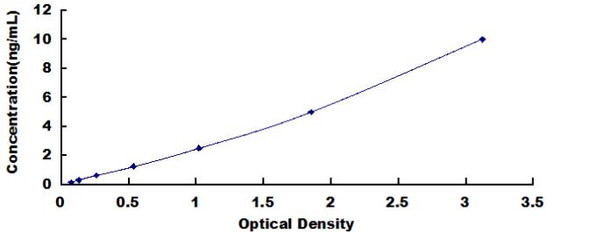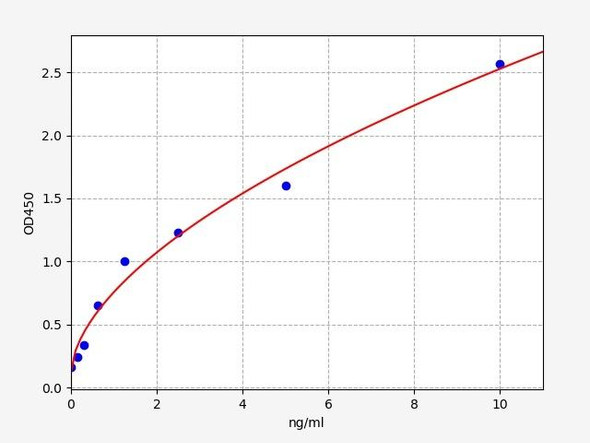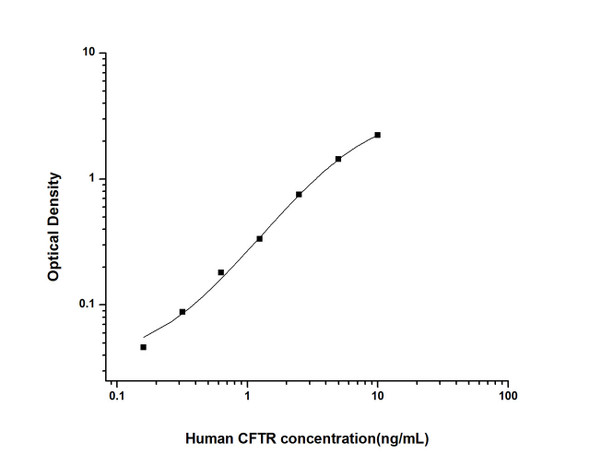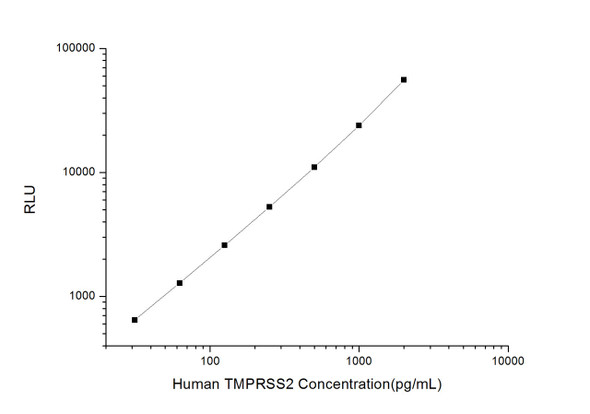Human Signal Transduction ELISA Kits
Human CFTR (Cystic Fibrosis Transmembrane Conductance Regulator) CLIA Kit (HUES00986)
- SKU:
- HUES00986
- Product Type:
- ELISA Kit
- ELISA Type:
- CLIA Kit
- Size:
- 96 Assays
- Sensitivity:
- 18.75pg/mL
- Range:
- 31.25-2000pg/mL
- ELISA Type:
- Sandwich
- Reactivity:
- Human
- Sample Type:
- Serum, plasma and other biological fluids
- Research Area:
- Signal Transduction
Description
| Assay type: | Sandwich |
| Format: | 96T |
| Assay time: | 4.5h |
| Reactivity: | Human |
| Detection method: | Chemiluminescence |
| Detection range: | 31.25-2000 pg/mL |
| Sensitivity: | 18.75 pg/mL |
| Sample volume: | 100µL |
| Sample type: | Serum, plasma and other biological fluids |
| Repeatability: | CV < 15% |
| Specificity: | This kit recognizes Human CFTR in samples. No significant cross-reactivity or interference between Human CFTR and analogues was observed. |
This kit uses Sandwich-CLIA as the method. The micro CLIA plate provided in this kit has been pre-coated with an antibody specific to Human CFTR. Standards or samples are added to the appropriate micro CLIA plate wells and combined with the specific antibody. Then a biotinylated detection antibody specific for Human CFTR and Avidin-Horseradish Peroxidase (HRP) conjugate are added to each micro plate well successively and incubated. Free components are washed away. The substrate solution is added to each well. Only those wells that contain Human CFTR, biotinylated detection antibody and Avidin-HRP conjugate will appear fluorescence. The Relative light unit (RLU) value is measured spectrophotometrically by the Chemiluminescence immunoassay analyzer. The RLU value is positively associated with the concentration of Human CFTR. The concentration of Human CFTR in the samples can be calculated by comparing the RLU of the samples to the standard curve.
| UniProt Protein Function: | CFTR: a member of the MRP subfamily of ATP-binding cassette (ABC) transporters. ABC proteins transport various molecules across extra- and intra-cellular membranes. Functions as a chloride channel and controls the regulation of other transport pathways. Mutations have been observed in patients with the autosomal recessive disorders cystic fibrosis (CF) and congenital bilateral aplasia of the vas deferens (CBAVD). Alternative splice |
| UniProt Protein Details: | Protein type:Membrane protein, multi-pass; Channel, chloride; Transporter, ABC family; Membrane protein, integral; Transporter; Hydrolase; EC 3. 6. 3. 49 Chromosomal Location of Human Ortholog: 7q31. 2 Cellular Component: recycling endosome; cell surface; cytoplasmic vesicle membrane; microvillus; protein complex; early endosome membrane; basolateral plasma membrane; apical plasma membrane; early endosome; cytoplasm; plasma membrane Molecular Function:bicarbonate transmembrane transporter activity; protein binding; chloride channel activity; enzyme binding; chloride channel inhibitor activity; chloride transmembrane transporter activity; channel-conductance-controlling ATPase activity; ATP-binding and phosphorylation-dependent chloride channel activity; ATP binding; PDZ domain binding Biological Process: intracellular pH elevation; response to drug; response to peptide hormone stimulus; cholesterol transport; iodide transport; transepithelial chloride transport; water transport; membrane hyperpolarization; respiratory gaseous exchange; positive regulation of vasodilation; cholesterol biosynthetic process; vasodilation; cellular response to hormone stimulus; response to estrogen stimulus; bicarbonate transport; transport; response to cytokine stimulus; transmembrane transport; sperm capacitation; lung development Disease: Vas Deferens, Congenital Bilateral Aplasia Of; Bronchiectasis With Or Without Elevated Sweat Chloride 1; Cystic Fibrosis; Pancreatitis, Hereditary |
| NCBI Summary: | This gene encodes a member of the ATP-binding cassette (ABC) transporter superfamily. ABC proteins transport various molecules across extra- and intra-cellular membranes. ABC genes are divided into seven distinct subfamilies (ABC1, MDR/TAP, MRP, ALD, OABP, GCN20, White). This protein is a member of the MRP subfamily that is involved in multi-drug resistance. The encoded protein functions as a chloride channel and controls the regulation of other transport pathways. Mutations in this gene are associated with the autosomal recessive disorders cystic fibrosis and congenital bilateral aplasia of the vas deferens. Alternatively spliced transcript variants have been described, many of which result from mutations in this gene. [provided by RefSeq, Jul 2008] |
| UniProt Code: | P13569 |
| NCBI GenInfo Identifier: | 90421313 |
| NCBI Gene ID: | 1080 |
| NCBI Accession: | NP_000483. 3 |
| UniProt Secondary Accession: | P13569,Q20BG8, Q20BH2, Q2I0A1, Q2I102, |
| UniProt Related Accession: | P13569 |
| Molecular Weight: | 69,230 Da |
| NCBI Full Name: | cystic fibrosis transmembrane conductance regulator |
| NCBI Synonym Full Names: | cystic fibrosis transmembrane conductance regulator (ATP-binding cassette sub-family C, member 7) |
| NCBI Official Symbol: | CFTR |
| NCBI Official Synonym Symbols: | CF; MRP7; ABC35; ABCC7; CFTR/MRP; TNR-CFTR; dJ760C5. 1 |
| NCBI Protein Information: | cystic fibrosis transmembrane conductance regulator |
| UniProt Protein Name: | Cystic fibrosis transmembrane conductance regulator |
| UniProt Synonym Protein Names: | ATP-binding cassette sub-family C member 7; Channel conductance-controlling ATPase (EC:3. 6. 3. 49); cAMP-dependent chloride channel |
| Protein Family: | Cystic fibrosis transmembrane conductance regulator |
| UniProt Gene Name: | CFTR |
| UniProt Entry Name: | CFTR_HUMAN |
As the RLU values of the standard curve may vary according to the conditions of the actual assay performance (e. g. operator, pipetting technique, washing technique or temperature effects), the operator should establish a standard curve for each test. Typical standard curve and data is provided below for reference only.
| Concentration (pg/mL) | RLU | Average | Corrected |
| 2000 | 54835 56607 | 55721 | 55693 |
| 1000 | 23287 24661 | 23974 | 23946 |
| 500 | 11602 10462 | 11032 | 11004 |
| 250 | 5047 5541 | 5294 | 5266 |
| 125 | 2653 2563 | 2608 | 2580 |
| 62.5 | 1362 1260 | 1311 | 1283 |
| 31.25 | 671 677 | 674 | 646 |
| 0 | 28 28 | 28 | -- |
Precision
Intra-assay Precision (Precision within an assay): 3 samples with low, mid range and high level Human CFTR were tested 20 times on one plate, respectively.
Inter-assay Precision (Precision between assays): 3 samples with low, mid range and high level Human CFTR were tested on 3 different plates, 20 replicates in each plate.
| Intra-assay Precision | Inter-assay Precision | |||||
| Sample | 1 | 2 | 3 | 1 | 2 | 3 |
| n | 20 | 20 | 20 | 20 | 20 | 20 |
| Mean (pg/mL) | 96.89 | 181.75 | 807.97 | 91.55 | 187.83 | 871.11 |
| Standard deviation | 9.57 | 13.16 | 75.79 | 11.79 | 22.22 | 73.52 |
| C V (%) | 9.88 | 7.24 | 9.38 | 12.88 | 11.83 | 8.44 |
Recovery
The recovery of Human CFTR spiked at three different levels in samples throughout the range of the assay was evaluated in various matrices.
| Sample Type | Range (%) | Average Recovery (%) |
| Serum (n=5) | 96-111 | 102 |
| EDTA plasma (n=5) | 99-114 | 107 |
| Cell culture media (n=5) | 87-100 | 94 |
Linearity
Samples were spiked with high concentrations of Human CFTR and diluted with Reference Standard & Sample Diluent to produce samples with values within the range of the assay.
| Serum (n=5) | EDTA plasma (n=5) | Cell culture media (n=5) | ||
| 1:2 | Range (%) | 85-99 | 86-98 | 101-117 |
| Average (%) | 92 | 92 | 109 | |
| 1:4 | Range (%) | 90-102 | 89-103 | 87-99 |
| Average (%) | 96 | 94 | 93 | |
| 1:8 | Range (%) | 89-101 | 84-97 | 101-116 |
| Average (%) | 95 | 91 | 109 | |
| 1:16 | Range (%) | 91-105 | 98-112 | 89-102 |
| Average (%) | 99 | 106 | 96 |
An unopened kit can be stored at 4°C for 1 month. If the kit is not used within 1 month, store the items separately according to the following conditions once the kit is received.
| Item | Specifications | Storage |
| Micro CLIA Plate(Dismountable) | 8 wells ×12 strips | -20°C, 6 months |
| Reference Standard | 2 vials | |
| Concentrated Biotinylated Detection Ab (100×) | 1 vial, 120 µL | |
| Concentrated HRP Conjugate (100×) | 1 vial, 120 µL | -20°C(shading light), 6 months |
| Reference Standard & Sample Diluent | 1 vial, 20 mL | 4°C, 6 months |
| Biotinylated Detection Ab Diluent | 1 vial, 14 mL | |
| HRP Conjugate Diluent | 1 vial, 14 mL | |
| Concentrated Wash Buffer (25×) | 1 vial, 30 mL | |
| Substrate Reagent A | 1 vial, 5 mL | 4°C (shading light) |
| Substrate Reagent B | 1 vial, 5 mL | 4°C (shading light) |
| Plate Sealer | 5 pieces | |
| Product Description | 1 copy | |
| Certificate of Analysis | 1 copy |
- Set standard, test sample and control (zero) wells on the pre-coated plate and record theirpositions. It is recommended to measure each standard and sample in duplicate. Note: addall solutions to the bottom of the plate wells while avoiding contact with the well walls. Ensuresolutions do not foam when adding to the wells.
- Aliquot 100 µL of standard solutions into the standard wells.
- Add 100 µL of Sample / Standard dilution buffer into the control (zero) well.
- Add 100 µL of properly diluted sample (serum, plasma, tissue homogenates and otherbiological fluids. ) into test sample wells.
- Cover the plate with the sealer provided in the kit and incubate for 90 min at 37 °C.
- Aspirate the liquid from each well, do not wash. Immediately add 100 µL of BiotinylatedDetection Ab working solution to each well. Cover the plate with a plate seal and gently mix. Incubate for 1 hour at 37 °C.
- Aspirate or decant the solution from the plate and add 350 µL of wash buffer to each welland incubate for 1-2 minutes at room temperature. Aspirate the solution from each well andclap the plate on absorbent filter paper to dry. Repeat this process 3 times. Note: a microplatewasher can be used in this step and other wash steps.
- Add 100 µL of HRP Conjugate working solution to each well. Cover with a plate seal andincubate for 30 min at 37 °C.
- Aspirate or decant the solution from each well. Repeat the wash process for five times asconducted in step 7.
- Add 100 µL of Substrate mixture solution to each well. Cover with a new plate seal andincubate for no more than 5 min at 37 °C. Protect the plate from light.
- Determine the RLU value of each well immediately.






